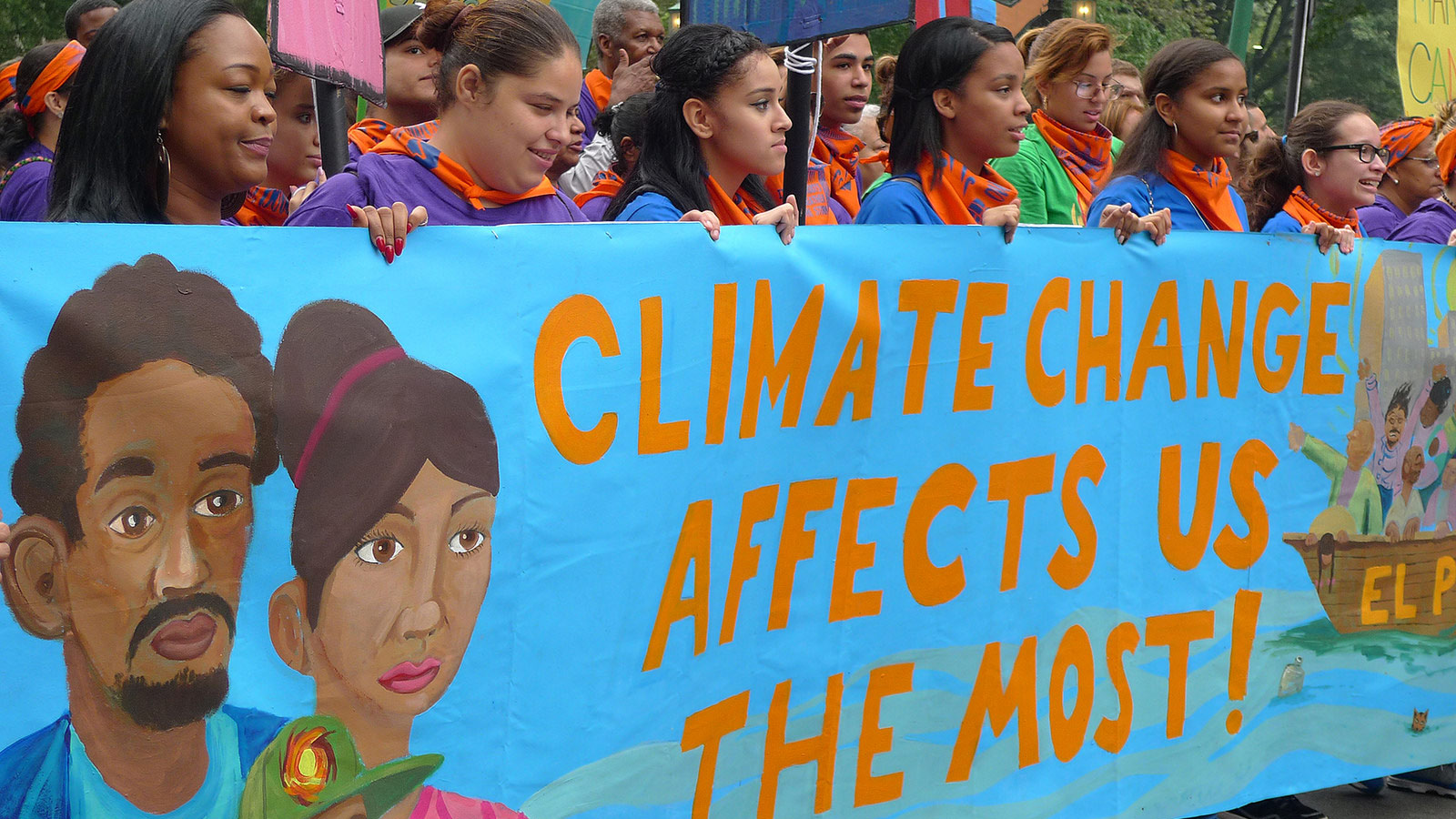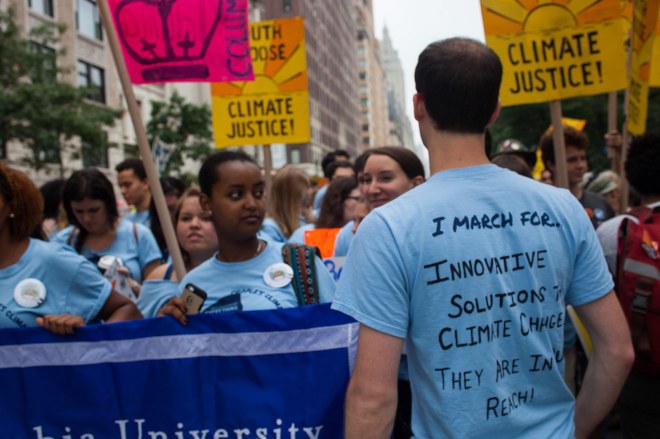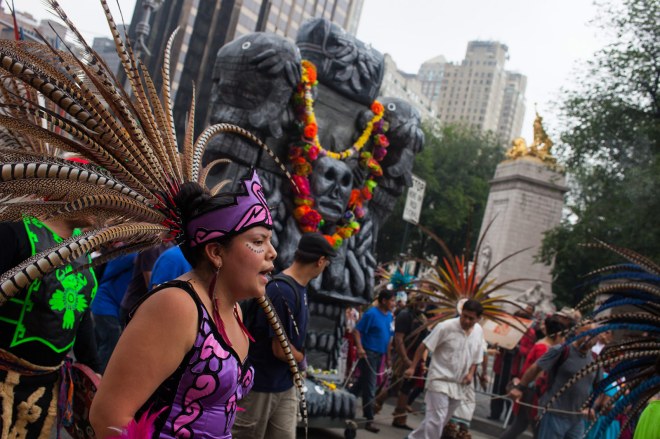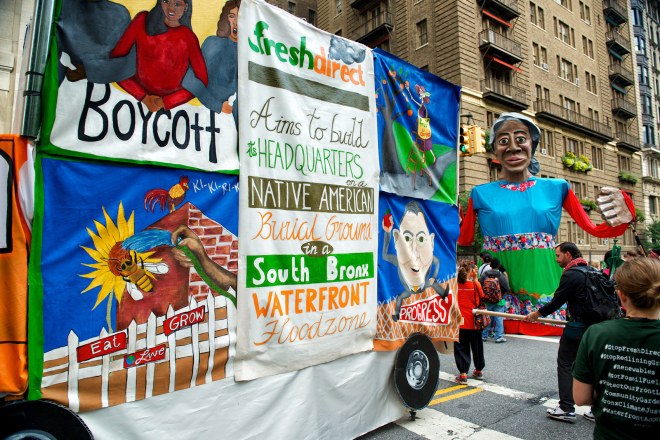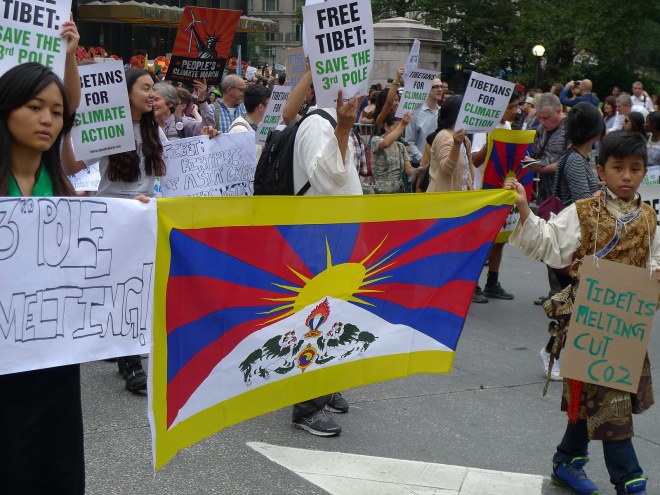A subway advertisement from the New York City Office of Emergency Management asks, “Do you live in one of NYC’s six hurricane evacuation zones? Know your zone.” As activists piled into the train on their way to the People’s Climate March on Sunday morning, it seemed an appropriate omen.
The march’s central aim was to bring the people on the frontlines of the climate crisis to the center of global capitalism, to force the media and the world leaders assembled for the United Nations General Assembly this week to look.
The organizers estimate 310,000 people showed up, which vastly exceeded both their public prediction of 100,000 and even their higher private projections. [Update: Organizers later increased their attendance estimate to nearly 400,000.] Critics may come up with lower numbers, but the following facts are inarguable: The marchers lined up along Manhattan’s Central Park West from 61st Street to 96th Street, which is 1.5 miles. They started marching at 11:30 a.m., and the back of the crowd still hadn’t moved by 1:45. There were a lot of people.
And they were the most diverse assemblage any American protest has seen in quite some time, possibly ever. About 1,500 organizations sponsored the march, and countless other less formal groups marched together. From a U.S. “Cowboys and Indians” contingent protesting the Keystone XL pipeline, to Latin Americans up from countries like Bolivia and El Salvador protesting deforestation and fossil fuel exploration on their lands, to Indonesians fearing their islands will sink under water, to residents of New York’s own most disadvantaged neighborhoods and some of its affluent waterfront suburbs, they were all people who have a personal stake in averting catastrophic global warming.
There was no singular rally, and there were no speeches by big shots. Instead the march was preceded by a press conference with brief comments from regular people who have been affected by climate change, and a collection of small rallies for specific constituencies. The speakers at the press conference each hailed from one of the main blocs in attendance: local New Yorkers affected by Sandy, indigenous communities fighting fossil fuel exploration, islanders facing submergence, residents of coal country who’ve been afflicted by coal’s corrosive effects on the local air and water. The latter were represented by Stanley Sturgill, a retired coal miner from Kentucky suffering from black lung disease.
Kathy Jetnil-Kijiner, a woman from the Marshall Islands who is in town for Tuesday’s U.N. Climate Summit, hit on a theme echoed on many of the signs held by marchers: that there is no alternative to the Earth if we destroy it. “We only have one atmosphere and we of the Marshall Islands only have one land to call home,” she said. Or, as many of the signs put it, “There is no Planet B.”
At a pre-march rally put on by labor unions, one could see just how broad a coalition was participating in the march. Some of the unions present, like the Service Employees International Union, were largely young, female, and non-white. But there were representatives of traditional industrial labor unions holding up placards too. The United Auto Workers was there, as were a contingent of terse white men from the International Brotherhood of Teamsters. Asked why they were sponsors, Teamster Local 813 shop steward Charlie Morell said only, “Green jobs.” Asked to elaborate on the green jobs that the Teamsters hope to see created, he offered, “Recycling. Hybrid trucks.” You can’t argue with that.
Many of the indigenous groups were at the front of the march, behind a banner reading, “Frontlines of Crisis, Forefront of Change.” There was a headdress-wearing group from Latin America that began with an Aztec ceremonial dance and drum song. Others, including marchers from local New York economic- and environmental-justice organizations like West Harlem Environmental Action, led chants like, “Climate justice is our right / What do we do? Fight, fight, fight!” and “We want climate justice now / Listen up, we’ll show you how!”
There were college students from all over the country, including 83 historically black colleges and universities. For many students, it was their first rally. “This is our generation’s movement,” said Jenise Young, 33, a doctoral student in environmental policy at Texas Southern University. “I had to come. I had no choice.”
Closer to home, the Shorefront Communities Unit held symbolic life rafts with the names of their low-lying New York City neighborhoods like Rockaway Park and Mill Basin. There were suburbanites, like the Castlowitz family from Long Beach, on Long Island, holding signs saying, “Don’t drown our town.” Ray Figueroa, marching with the South Bronx Unity group, is president of the New York City Community Garden Coalition. He was eager to discuss the importance of community gardens, which sequester carbon and provide locally sourced food, and the need for public policies to support their development and maintenance in low-income communities.
As author Naomi Klein said to Grist of the march’s impressive diversity, “This looks like New York.”
The flip side of the broad cacophony was a lack of focus. It seemed as if each group in attendance had its own, very specific demand. Much of the South Bronx group was chanting for a boycott of FreshDirect because the online grocer intends to house trucking operations in the South Bronx. Activists contend that this will aggravate the area’s high rate of asthma, and that the facility will be in a flood zone vulnerable to sea level rise.
There was a Free Tibet delegation, holding signs and shouting, “Protect the Third Pole” — a reference to Tibet’s extensive ice sheet, the world’s third largest after the North and South Poles — and, of course, calling for a free Tibet.
There were opponents of various pipelines, not just Keystone but smaller ones like the proposed Northeast Energy Direct in Massachusetts. Many of the groups were complaining about the ill effects of the things that cause climate change — coal mining, fracking, trucking, deforestation — rather than about climate change per se.
Just Associates, an international organization of indigenous women, had attendees from Latin America and Asia carrying signs opposing pineapple plantations in Costa Rica and palm plantations in Indonesia. They were in town for the International Conference on Population and Development that is, like the Climate Summit, part of the U.N. General Assembly this week. “They’re destroying our forest and land, and contaminating our water with chemicals,” said Heydi Murillo of Costa Rica, referring to the pineapple farms.
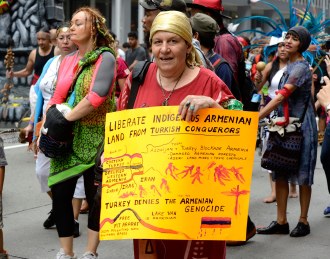
Stephen MelkisethianThis woman was more off-message than most.
These are no doubt all worthy causes. And the march’s organizers deliberately tried to be inclusive and avoid specifics in order attract as many people from as wide a geographical range as possible. Some might wonder, though, if a march calling for everything from boycotting FreshDirect to halting the development of pineapple plantations in Costa Rica to freeing Tibet runs the risk of asking for too much and winding up with nothing.
Ultimately, the march was a successful expression of organizers’ larger strategy: not to go to the wall for one specific, immediate demand — like, say, the protesters tying themselves to the White House fence to stop Keystone — but to build a grassroots movement.
“This thing was a success before we even took one step, because so many people came together,” said Figueroa. In some sense, that’s true. But in another, by even the march organizers’ own admission, the real measure of its accomplishment is yet to come. Said Leslie Cagan, the march’s logistics coordinator, “No one march, rally, or demonstration makes change. If half the people here go back and work on [climate change], if it leads to more media coverage of the issues, that’s a success.”

